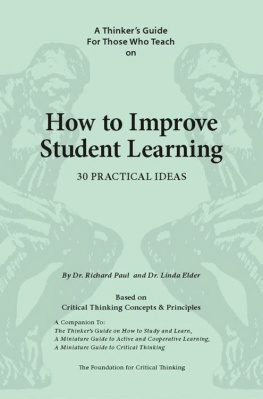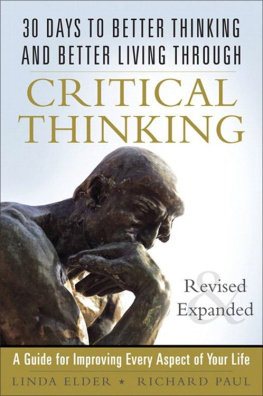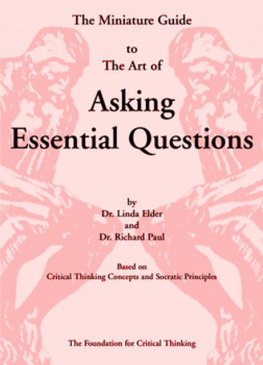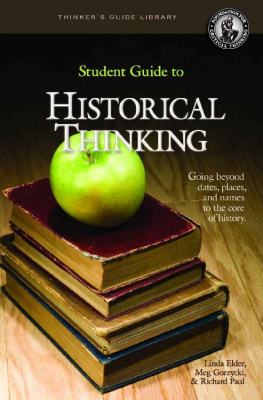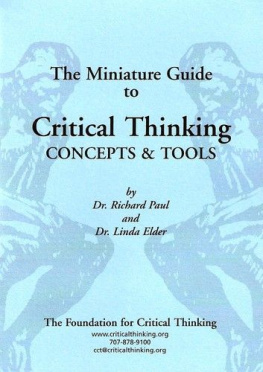Linda Elder - A Miniature Guide For Those Who Teach On How to Improve Student Learning
Here you can read online Linda Elder - A Miniature Guide For Those Who Teach On How to Improve Student Learning full text of the book (entire story) in english for free. Download pdf and epub, get meaning, cover and reviews about this ebook. year: 2011, publisher: Foundation for Critical Thinking, genre: Religion. Description of the work, (preface) as well as reviews are available. Best literature library LitArk.com created for fans of good reading and offers a wide selection of genres:
Romance novel
Science fiction
Adventure
Detective
Science
History
Home and family
Prose
Art
Politics
Computer
Non-fiction
Religion
Business
Children
Humor
Choose a favorite category and find really read worthwhile books. Enjoy immersion in the world of imagination, feel the emotions of the characters or learn something new for yourself, make an fascinating discovery.
- Book:A Miniature Guide For Those Who Teach On How to Improve Student Learning
- Author:
- Publisher:Foundation for Critical Thinking
- Genre:
- Year:2011
- Rating:5 / 5
- Favourites:Add to favourites
- Your mark:
- 100
- 1
- 2
- 3
- 4
- 5
A Miniature Guide For Those Who Teach On How to Improve Student Learning: summary, description and annotation
We offer to read an annotation, description, summary or preface (depends on what the author of the book "A Miniature Guide For Those Who Teach On How to Improve Student Learning" wrote himself). If you haven't found the necessary information about the book — write in the comments, we will try to find it.
A Miniature Guide For Those Who Teach On How to Improve Student Learning — read online for free the complete book (whole text) full work
Below is the text of the book, divided by pages. System saving the place of the last page read, allows you to conveniently read the book "A Miniature Guide For Those Who Teach On How to Improve Student Learning" online for free, without having to search again every time where you left off. Put a bookmark, and you can go to the page where you finished reading at any time.
Font size:
Interval:
Bookmark:
The Thinker's Guide on How to Study and Learn,
A Miniature Guide to Active and Cooperative Learning,
A Miniature Guide to Critical Thinking
- that to learn a subject well, students must master the thinking that defines that subject, and
- that we, in turn, as their instructors, must design activities and assignments that require students to think actively within the concepts and principles of the subject.
Students should master fundamental concepts and principles before they attempt to learn more advanced concepts. If class time is focused on helping students perform well on these foundational activities, we feel confident that the goals of most instruction will be achieved.
It is up to you, the instructor, to decide which of these ideas you will test in the classroom. Only you can decide how to teach your students. Our goal is not to dictate to you, but to provide you with possible strategies with which to experiment. The specific suggestions we recommend represent methods and strategies we have developed and tested with our students. Judge for yourself their plausibility. Test them for their practicality. Those that work (i.e., improve instruction) keep; those that do not work, abandon or re-design.
The suggestions overlap each other and make most sense when taken together, as an interrelated network. Often one suggestion is made intelligible in the light of two or three others. So if one is not clear to you, read on. The strength of each of them, in re-enforcing each other, will then become increasingly clear.

Richard Paul
Center for Critical Thinking

Linda Elder
Foundation for Critical Thinking

If students are to acquire understandings and skills, we need to provide many opportunities for them to
- internalize the key concepts in the subject, and to
- apply those concepts to problems and issues (in their lives or in their coursework).


Place the students into groups of three, each with a letter assigned (A, B, or C). You then read a paragraph or two out of the text aloud slowly, commenting on what you are reading as you are reading, explaining what is making immediate sense to you and what you need to figure out by further reading. After modeling in this manner for a couple of paragraphs, you ask A to take over and read aloud to B and C, explaining to them, sentence by sentence, what he/she is able to figure out and what he/she is not. After A is finished with two paragraphs, then B and C comment on what they do and do not understand (in the paragraphs that A read). Then you read aloud to the whole class the two paragraphs that A read, commenting as you go. Then B takes over and reads the next two paragraphs to A and C. Then A and C add their thoughts. Then you read aloud what B read. Then you go on to C who reads the next two paragraphs to A and B. And so on. As the students are reading in their groups of three, you are circulating around the room listening in and getting an idea of the level of proficiency of their critical reading. The more you use this process, the better students become at critical reading. When they become proficient at it, they begin to ask questions in their own minds as they read, clarifying as they read, questioning what they do not understand.
See also the thinkers guide to How to Read a Paragraph (The Art of Close Reading).

Because of the importance of self-assessment to critical thinking, it is important to bring it into the structural design of the course and not just leave it to random or chance use. Here are a variety of strategies that can be used for fostering self-assessment through peer-assessment:
Font size:
Interval:
Bookmark:
Similar books «A Miniature Guide For Those Who Teach On How to Improve Student Learning»
Look at similar books to A Miniature Guide For Those Who Teach On How to Improve Student Learning. We have selected literature similar in name and meaning in the hope of providing readers with more options to find new, interesting, not yet read works.
Discussion, reviews of the book A Miniature Guide For Those Who Teach On How to Improve Student Learning and just readers' own opinions. Leave your comments, write what you think about the work, its meaning or the main characters. Specify what exactly you liked and what you didn't like, and why you think so.

